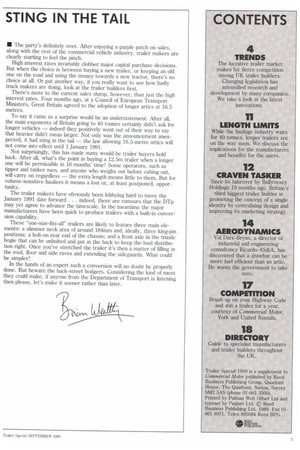STING IN THE TAIL
Page 119

If you've noticed an error in this article please click here to report it so we can fix it.
• The party's definitely over. After enjoying a purple patch on sales, along with the rest of the commercial vehicle industry, trailer makers are clearly starting to feel the pinch.
High interest rates invariably clobber major capital purchase decisions. But when the choice is between buying a new trailer, or keeping an old one on the road and using the money towards a new tractor, there's no choice at all. Or put another way, if you really want to see how badly truck makers are doing, look at the trailer builders first.
There's more to the current sales slump, however, than just the high interest rates. Four months ago, at a Council of European Transport Ministers, Great Britain agreed to the adoption of longer artics at 16.5 metres.
To say it came as a surprise would be an understatement. After all, the main exponents of Britain going to 40 tonnes certainly didn't ask for longer vehicles — indeed they positively went out of their way to say that heavier didn't mean larger. Not only was the announcement unexpected, it had sting in the tail — the law allowing 16.5-metre artics will not come into effect until 1 January 1991.
Not surprisingly, this has made many would-be trailer buyers hold back. After all, what's the point in buying a 12.5m trailer when a longer one will be permissible in 16 months' time? Some operators, such as tipper and tanker men, and anyone who weighs out before cubing out, will carry on regardless — the extra length means little to them. But for volume-sensitive hauliers it means a lost or, at least postponed, opportunity.
The trailer makers have obviously been lobbying hard to move the January 1991 date forward. . . indeed, there are rumours that the DTp may yet agree to advance the tirnescale. In the meantime the major manufacturers have been quick to produce trailers with a built-in conversion capability.
These "one-size-fits-all" trailers are likely to feature three main elements: a slimmer neck area of around 184mm and, ideally, three king-pin positions; a bolt-on rear end of the chassis; and a front axle in the triaxle bogie that can be unbolted and put at the back to keep the load distribution right. Once you've stretched the trailer it's then a matter of filling in the roof, floor and side raves and extending the sideguards. What could be simpler?
In the hands of an expert such a conversion will no doubt be properly done. But beware the back-street bodgers. Considering the kind of mess they could make, if anyone from the Department of Transport is listening then please, let's make it sooner rather than later.




























































































































































